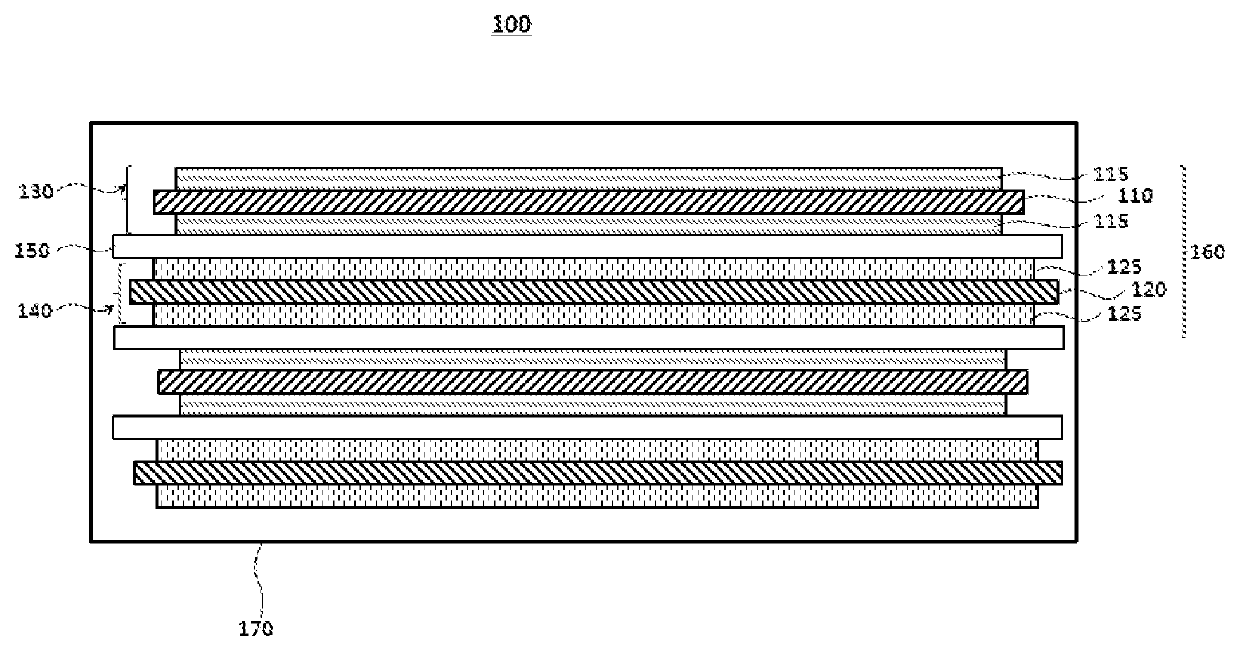Electrolyte for lithium secondary battery and lithium secondary battery including the same
a lithium secondary battery and lithium secondary battery technology, which is applied in the direction of batteries, cell components, electrochemical generators, etc., can solve the problems of insufficient improvement, increased thickness of electrodes, increased internal resistance of batteries, etc., and achieve excellent life-span characteristics, excellent stability, and effective suppression of an increase in electrode thickness
- Summary
- Abstract
- Description
- Claims
- Application Information
AI Technical Summary
Benefits of technology
Problems solved by technology
Method used
Image
Examples
examples 1 to 5
[0139]Electrolytes of Examples 1 to 5 were prepared by adding polyethylene glycol dimethyl ethers having a weight average molecular weight (Mw) of about 1,000, 2,000, 5,000, 10,000 and 20,000, respectively, to the base electrolyte of Comparative Example 1 so as to be an amount of 1 wt. % based on the total weight of the electrolyte.
preparation example
ium Secondary Battery
[0140]A cathode slurry was prepared by mixing 92 wt. % of a cathode active material in which Li[Ni0.6Co0.2Mn0.2]O2 and Li[Ni0.8Co0.1Mn0.1]O2 are mixed in a weight ratio of 6:4, 3 wt. % of polyvinylidene fluoride (PVdF) as a binder, and 5 wt. % of carbon black as a conductive material.
[0141]The prepared cathode slurry was uniformly applied to an aluminum foil having a thickness of 15 μm, followed by drying and rolling to prepare a cathode.
[0142]An anode slurry was prepared by mixing 97 wt. % of an anode active material in which artificial graphite and natural graphite were mixed in a weight ratio of 7:3, 1 wt. % of styrene-butadiene rubber (SBR) as a binder, and 2 wt. % of carboxymethyl cellulose (CMC) as a thickener.
[0143]The prepared anode slurry was uniformly applied to a copper foil having a thickness of 15 μm, followed by drying and rolling to prepare an anode having a density of 1.684 g / cm3.
[0144]The prepared cathode and anode were cut into a predetermined ...
experimental example 1
n (Evaluation of Capacity Retention Rate after Charging and Discharging 600 Times) at 45° C.
[0148]Charging (CC / CV 1C 4.2 V 0.1C CUT-OFF) and discharging (CC 1C 2.7 V CUT-OFF) the lithium secondary batteries of the examples and comparative examples were repeated 600 times at 45° C.
[0149]A capacity retention rate after charging and discharging 600 times was calculated as a percentage (%) by dividing the discharge capacity at 600th charging and discharging (hereinafter, abbreviated as “600th discharge capacity”) by the discharge capacity at the first (initial capacity) charging and discharging (hereinafter, abbreviated as “1st discharge capacity”) as follows.
Capacity retention rate (%)=(600th discharge capacity / 1st discharge capacity)×100
PUM
 Login to View More
Login to View More Abstract
Description
Claims
Application Information
 Login to View More
Login to View More - R&D
- Intellectual Property
- Life Sciences
- Materials
- Tech Scout
- Unparalleled Data Quality
- Higher Quality Content
- 60% Fewer Hallucinations
Browse by: Latest US Patents, China's latest patents, Technical Efficacy Thesaurus, Application Domain, Technology Topic, Popular Technical Reports.
© 2025 PatSnap. All rights reserved.Legal|Privacy policy|Modern Slavery Act Transparency Statement|Sitemap|About US| Contact US: help@patsnap.com



